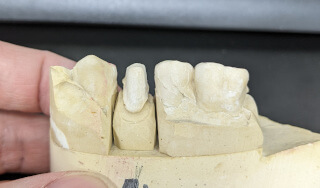Crown Fell Out No Tooth Left, How Bad Is It?
- David Chen, DDS
- Dec 7, 2023
- 4 min read
Updated: Dec 8, 2023
If your crown fell out and there is no tooth left in the mouth, that means you've a tooth fracture. This is a serious dental condition that requires prompt treatment and is inherently different from just a crown falling off.

When there is no tooth left, it wasn't simply the dental glue that came loose. The treatment for this is similar to what you would do for a fractured tooth since the etiology is nearly identical.
Table of contents:
It's a tooth fracture
Hate to be the bearer of bad news but your crown fell off because your tooth fractured. That means the root cause of this mishap is due to a weakened tooth underneath of the crown. It became weakened to the point where it could not withstand masticatory forces and ultimately broke off with the crown attached to it.
Potential causes:
Decay underneath crown. The crown itself is immune to tooth decay but your tooth underneath of it isn't. Cavities can sneak in through the crown margins.
Not enough natural tooth structure. Most teeth with caps on them have a core build up or a post and core. If the ratio of natural tooth to core material is poor, it will be more prone to fractures.
Eating hard foods. Accidentally biting into hard foods will crack even natural teeth. Just because a tooth has been capped does not make it immune to accidents.
This is the same condition as when a permanent crown falls off with the post attached or with a piece of tooth attached to it. Yes, they're all tooth fractures!
Treatment
Unfortunately if there is no tooth left after the crown falls off, the only treatment option left is a tooth extraction. Essentially all that is left of your tooth is just the tooth root still in the gums.
The prognosis is extremely poor if there is not enough tooth structure left after the fracture. Even if it doesn't hurt at all, you still need treatment as soon as possible. The best option would be to remove the rest of the tooth underneath the gum. Afterwards you can think about replacing the missing tooth.
Options for missing tooth replacement:
Dental implant. A titanium screw that gets placed into the jaw. Afterwards an implant crown is put over the implant.
Bridge. Shave down the two adjacent teeth and fabricate a dental bridge.
Partial denture. If finances are a problem, a denture would be the least expensive option. This is considered a removable option because you can remove it at will.
Can't you put another crown on it?
It is not advisable to attempt another crown because there isn't enough tooth to hold the crown. In order for your tooth to retain the tooth cap properly, it needs a certain amount of tooth structure.
A lot of tooth structure equates to a very retentive crown with a good prognosis.
No tooth structure left equates to a non-retentive crown with a poor prognosis.
The two images above demonstrate what we mean by "enough tooth structure left". The first photo has a normal sized clinical crown where you can see there is a lot of tooth left for a crown to fit over. The second photo has a very short clinical crown which will have trouble holding the crown on.
The consequence of trying to put a crown on a very little to no tooth structure would be crowns that repeatedly fall off. You'll be back at the dentist every month trying to reglue it back in once again.
Alternative treatment
The best option would be to extract the remaining part of the tooth and then replace the missing tooth. However if you are absolutely opposed to taking out teeth, there are two creative options but they do come with downsides.
Crown lengthening
Since there is not enough tooth left to put a new crown on after the old one has fallen off, you can make the tooth longer via crown lengthening. This procedure shaves away the bone and gums around the broken tooth in order to make the tooth "longer". Essentially it reveals more of the tooth root above the gum line so you can put a crown over it.
The downside to this novel procedure is that it may make the adjacent teeth more sensitive. When you shave away the bone and gums for the affected tooth, the adjacent teeth's gums usually shrink, thus leaving the dentin exposed. In other words it'll be more sensitive to
temperatures.
Orthodontic extrusion
Alternatively, you can undergo orthodontic treatment and have the orthodontist extrude the remaining tooth root. They will attach a braces bracket on it and pull the tooth out of the gums over the next few months.
The downside to this method is that it is extremely costly and takes a long time.
Costly - you have to pay for braces treatment in addition to getting a new crown.
Lengthy treatment - the tooth gets raised out of the gums over MONTHS. That is a long time frame to wait for this tooth to be ready to put a new tooth cap on.
What should I do?
There are pros and cons to each of the treatment as well as the alternatives. You should discuss with your dentist about which option to pursue because finances will play a large role in your decision.
Nonetheless, the point we want to get through to you is that if your crown falls off and there is no tooth left, it is a fracture. It will need to be treated by a dentist since there is nothing that you can do to save it at home.



